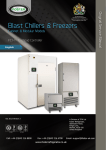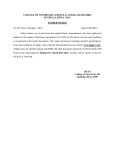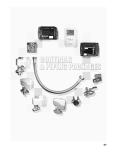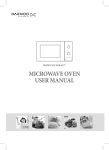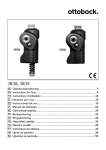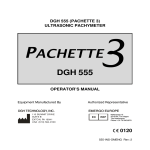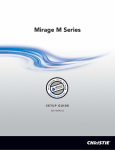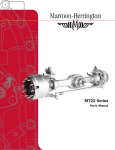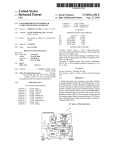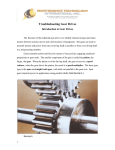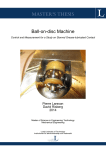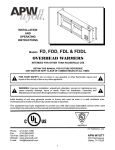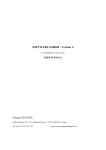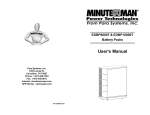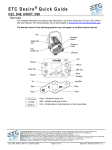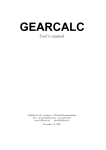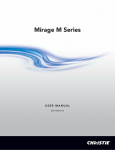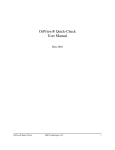Download UTS Integrated Gear Software
Transcript
UTS Integrated Gear Software Basic Gear Design and Manufacturing—Steel Gears Program 500 External Involute Gear Analysis This Program is an advanced gear analysis expert system for external involute gears and splines. It is based upon American Gear Manufacturers’ Association (AGMA) Information sheet 908-B89. The program analyzes spur or helical gear sets to be sure that each gear is compatible with its mate and with the tools that will be used in manufacturing. With the use of the program, you can verify that tools (such as hobs, shaper cutters, shaving cutters, grinding wheels, etc.) will produce the gears without problems in the gear shop. Program 500 has been configured to guide you as the design process continues with a series of dynamic defaults for most of the entries required. A large-scale plot of the gear tooth is provided as an aid to understanding the printed numerical data. The AGMA strength factor, J, and the AGMA durability factor, I, are calculated for all types of parallel axis involute gears covered by AGMA 908-B89. 60-050w First Gear First Gear is very useful in making preliminary design calculations for external spur and helical gears. The program automatically guides the user through various input data steps. It is simple enough for a beginner, yet powerful enough for an expert. Features include: plot of gear mesh, plot of gear with measurement pins (or balls), single key switch from inch to metric units (or vice versa), and standard as well as nonstandard gears. An estimate of load capacity is also calculated. A report includes input data and output calculations as well as plots. On-line, context sensitive help provides an excellent supplement to the user manual. 60-100w AGMA Gear Classification This program calculates the dimensional tolerances for unassembled spur, helical, double helical, and herringbone gears in accordance with ANSI/AGMA 2000-A88. The standard covers a range of .5 to 200 normal diametral pitch. The maximum pitch diameter covered is 400 inches. 60-102w Lead Mis-Match This is a program for lead mismatch calculations for pairs of gears in a housing. 60-103w Profile Shift Coefficients – External This model calculates the tooth thickness (for zero backlash) and outside diameters for two external gears from the profile shift coefficients. In European gear specifications the profile shift coefficients are usually specified as “X” factors. 60-104w Gear Mesh Geometry – External This is a model of the contact conditions between two external spur or helical involute gears. The contact ratios, start of active profile, specific sliding and many other geometrical conditions are calculated and checked. In addition, the tooth thickness, center distance and backlash are calculated. Basic Gear Design and Manufacturing—Steel Gears (continued) 60-107w Profile Shift Coefficients – Internal This model calculates the tooth thickness (for zero backlash), pinion outside diameter and gear inside diameter for internal gear set from the profile shift coefficients. In European gear specifications the profile shift coefficients are usually specified as “X” factors. 60-108w Gear Mesh Geometry – Internal This is a model of the contact conditions between two internal spur or helical involute gears. The contact ratios, start of active profile, specific sliding and many other geometrical conditions are calculated and checked. In addition, the tooth thickness, center distance and backlash are calculated. 60-145w Tooth Thickness Effective vs. Measured The measured and “effective” tooth thickness of involute gears and splines are usually different. Depending on the method used for the tooth thickness measurement, the difference between the measured value and the apparent, or effective, thickness “seen” by the mating gear or spline may be enough to prevent satisfactory use of the part. This program will make the required adjustments between the effective and measured tooth thickness for the usual measuring methods. 60-146w Center Distance – Temperature Effect This program calculates the changes in effective center distance due to changes in operating temperature when the gears and gear housing have different coefficients of thermal expansion. 60-180w Gear Set – Preliminary Sizing Once a target gear ratio has been determined and the load is known, the next step in the design process is to obtain the geometry for a preliminary gear set. This gear set is then checked with more detailed design equations to determine suitability for the loads and speeds involved (along with a duty cycle if applicable). This program is structured to produce a preliminary gear set from the data usually at hand when the ratio, load, and speed of a single gear set has been determined. 60-400w Gear Set – External – Tooth Plot This program will provide an accurate plot of the final form of external involute spur and helical gears in mesh at any position on the line of action. The data required by the program is from tool and production drawings only and provides a “final” visual check of the processes used to produce the design. 60-410w Gear – External – Coordinates This program provides an accurate plot of the tooth form produced by hobbing or shaping (and post processing) from the production gear drawing and the tool drawing. In the case of molded gears (plastic or powdered metal) circular arc fillets, chamfers and tip relief may be specified. A set of coordinates for the mold with shrinkage allowance is available. For form ground gears, the coordinates of the grinding wheel form are produced. Basic Gear Design and Manufacturing—Steel Gears (continued) 60-540w Gear Set - Stress/Life - B88 This program calculates load ratings for gear sets according to AGMA standard 2001-B88, Fundamental Rating Methods for Involute Spur and Helical Gear Teeth. This standard provides a method by which different gear designs can be compared. Most of the inputs for this program can be transferred automatically from Program 500. 60-541w Gear Set - Stress/Life - C95 This program calculates load ratings for gear sets according to AGMA standard 2001-C95, Fundamental Rating Methods for Involute Spur and Helical Gear Teeth. This standard provides a method by which, different gear designs can be compared. Most of the inputs for this program can be transferred automatically from Program 500. 60-1441w Gear - Ext - Measurement Over Pins This program calculates either the measurement over pins/balls or the length over a block of gear teeth from the tooth thickness. Measurement over pins or balls is used extensively for gears and splines and is a very accurate method for control of tooth thickness. By using different size pins or balls, a rough check can also be made of the involute profile. The program also calculates the diameter of a pin (or ball) that will contact the tooth flanks at the diameter where the tooth thickness is equal to the space width. The program may be used when the tooth thickness is known and the span size is needed. Basic Gear Design and Manufacturing—Plastic Gears 60-104w Gear Mesh Geometry External This is a model of the contact conditions between two external spur or helical involute gears. The contact ratios, start of active profile, specific sliding and many other geometrical conditions are calculated and checked. In addition, the tooth thickness, center distance and backlash are calculated. 60-108w Gear Mesh Geometry – Internal This is a model of the contact conditions between two internal spur or helical involute gears. The contact ratios, start of active profile, specific sliding and many other geometrical conditions are calculated and checked. In addition, the tooth thickness, center distance and backlash are calculated. 60-145w Tooth Thickness Effective vs. Measured The measured and “effective” tooth thickness of involute gears and splines are usually different. Depending on the method used for the tooth thickness measurement, the difference between the measured value and the apparent, or effective, thickness “seen” by the mating gear or spline may be enough to prevent satisfactory use of the part. This program will make the required adjustments between the effective and measured tooth thickness for the usual measuring methods. 60-146w Center Distance Temperature Effect This program calculates the changes in effective center distance due to changes in operating temperature when the gears and gear housing have different coefficients of thermal expansion. 60-180w Gear Set - Preliminary Sizing Once a target gear ratio has been determined and the load is known, the next step in the design process is to obtain the geometry for a preliminary gear set. This gear set is then checked with more detailed design equations to determine suitability for the loads and speeds involved (along with a duty cycle if applicable). This program is structured to produce a preliminary gear set from the data usually at hand when the ratio, load, and speed of a single gear set has been determined. 60-410w Gear - External – Coordinates This program provides an accurate plot of the tooth form produced by hobbing or shaping (and post processing) from the production gear drawing and the tool drawing. In the case of molded gears (plastic or powdered metal) circular arc fillets, chamfers and tip relief may be specified. A set of coordinates for the mold with shrinkage allowance is available. For form ground gears, the coordinates of the grinding wheel form are produced. 60-610w Gear - Design and Analysis – Plastic The purpose of this model is to provide an accurate set of coordinates for use in plotting the final form of external involute spur and helical plastic gears. In addition to a plot of the teeth, the model furnishes numerical results for many of the design parameters of interest to the designer. The model can be used for the design of a plastic gear set and the necessary tooling and, if load and material data is entered, an analysis of the load capacity will be made. Basic Gear Design and Manufacturing—Plastic Gears (continued) 60-1111w Gear Set - External - Tip Relief This program calculates the proper location and amount of tip (or root) relief for external involute gears by three different methods. The methods of Dudley and Sigg are used along with a direct method based on data furnished by AGMA Std. 2001. The deflection of the mesh is considered along with the allowable errors in the gears. 60-1441w Gear - Ext - Measurement Over Pins This program calculates either the measurement over pins/balls or the length over a block of gear teeth from the tooth thickness. Measurement over pins or balls is used extensively for gears and splines and is a very accurate method for control of tooth thickness. By using different size pins or balls, a rough check can also be made of the involute profile. The program also calculates the diameter of a pin (or ball) that will contact the tooth flanks at the diameter where the tooth thickness is equal to the space width. The program may be used when the tooth thickness is known and the span size is needed. Advanced Gear Design and Manufacturing Program 500 External Involute Gear Analysis This Program is an advanced gear analysis expert system for external involute gears and splines. It is based upon American Gear Manufacturers’ Association (AGMA) Information sheet 908-B89. The program analyzes spur or helical gear sets to be sure that each gear is compatible with its mate and with the tools that will be used in manufacturing. With the use of the program, you can verify that tools (such as hobs, shaper cutters, shaving cutters, grinding wheels, etc.) will produce the gears without problems in the gear shop. Program 500 has been configured to guide you as the design process continues with a series of dynamic defaults for most of the entries required. A large-scale plot of the gear tooth is provided as an aid to understanding the printed numerical data. The AGMA strength factor, J, and the AGMA durability factor, I, are calculated for all types of parallel axis involute gears covered by AGMA 908-B89. Program 580 Minimum Weight Gearbox This program is used to design a multi-stage gear unit with a minimum size and weight. It is also useful for estimating the cost and actual weight of a unit before it is manufactured. 60-101w ISO 1328 Cylindrical Gears This program calculates the dimensional tolerances for cylindrical gears in accordance with ISO 1328. The standard supplies single and cumulative pitch deviations, profile deviation, and helix deviation, depending upon the ISO accuracy grade (0-12). 60-124w Crossed Axis Contact – Cutters This program calculates the contact and crossed axis conditions for a gear in contact with a shaving cutter or hone. The root clearance, finished diameter, contact ratio and the crossed axis angle are solved from the tooth thickness and outside diameters. All values may be input or output data for checking or designing a cutter. 60-132w Tooth Thickness at Any Diameter This program calculates the tooth thickness (external gear) or space width (internal gear) at any diameter greater than the base diameter given the tooth thickness (or space width) and pressure angle at any other diameter. 60-136w Tooth Thickness From Chordal Dimensions The purpose of this program is to enable you to calculate the tooth thickness at the reference pitch diameter from the chordal caliper dimensions usually found on shaper cutter tool drawings and sometimes found on gear drawings. 60-150 Angular Position Variance This program calculates the angular position errors (index errors) produced by a train of gears due to the errors allowed by the AGMA tolerances for the gear quality class to which the individual gears are made. It is assumed that the maximum errors allowed are present in all the gears in the system. The statistical effect of the scatter in the actual errors is accounted for by calculating the root-mean-square index error. Advanced Gear Design and Manufacturing (continued) 60-151w Synchronic Index of Gear System This program calculates the synchronic index of an in-line geared transmission system. The synchronic index of a geared system is the minimum number of full turns made by the driver to bring the system back to the initial alignment of the gear teeth. After this number of turns, all gears will be back to their initial angular alignment with respect to each other and the gear housing. 60-164w Centers - Idler Gears Calculates the coordinates of the intersections of two circles. Its primary use is to locate the centers for idler gears. 60-166w Centers - Gear Mesh with Three Gears This is a model of a gear meshed with three other gears. Gear parameters such as number of teeth, contact ratios, approachrecess action, non-standard addendum, and center locations are calculated. The program’s primary use is for drives such as drill heads. 60-196w Involute Properties This program calculates the polar coordinates of an involute in terms of the diameter, roll angle, angle, and base diameter. The Cartesian coordinates are also given. The area, moment of inertia, and centroid of the involute sector is calculated. All values may be input or output data. 60-410w Gear - External – Coordinates This program provides an accurate plot of the tooth form produced by hobbing or shaping (and post processing) from the production gear drawing and the tool drawing. In the case of molded gears (plastic or powdered metal) circular arc fillets, chamfers and tip relief may be specified. A set of coordinates for the mold with shrinkage allowance is available. For form ground gears, the coordinates of the grinding wheel form are produced. 60-411w Gear - External - Tooth Gen by Hob This program will plot the transverse plane projection of the positions of the cutting edges of a hob. (The transverse plane is the plane of rotation of the gear.) It may be used to evaluate the suitability of a hob for the production of a gear. Non-topping, semi-topping, topping, or tip relief hobs may be used. If a roughing hob is used prior to a semi-finishing or finishing hob, the program will provide a plot of both profile patterns. 60-460w Gear - Internal – Coordinates This program provides an accurate plot of the tooth form produced by shaping (and post processing) from the production gear drawing and the tool drawing. In the case of molded gears (plastic or powdered metal), circular arc fillets, chamfers, and tip relief may be specified. A set of coordinates for the mold with shrinkage allowance is available. For form ground gears, the coordinates of the grinding wheel form are produced. Advanced Gear Design and Manufacturing (continued) 60-542XA ISO 6336 - Spur & Single Helical Gears This program calculates the load capacity of spur and single helical gears in accordance with ISO Standard 6336. 60-560w Gear - External Scoring This program is written in accordance with AGMA Standard 217.01 to provide data on the scoring resistance of gear sets used in aerospace applications. In addition, data on the probability of scoring using other than the two oils covered by the standard has been included. 60-750w Involute Splines - Set Geometry and Plot This model will allow you to check the suitability of spline cutting or molding tools to produce an internal/external spline set or to design new tools. A plot of the splined parts in assembly is provided for a visual check of the geometry in addition to numerical data. 60-1103w Gear - Internal - Shaper Cutter Contact This is a model of the contact conditions between an external involute shaper cutter and an internal gear. The possibility of the shaper tooth tip trimming the inner part of the gear tooth as the shaper is fed to full cutting depth is checked. In addition, involute and trochoidal interference is checked. 60-1111w Gear Set - External - Tip Relief This program calculates the proper location and amount of tip (or root) relief for external involute gears by three different methods. The methods of Dudley and Sigg are used along with a direct method based on data furnished by AGMA Std. 2001. The deflection of the mesh is considered along with the allowable errors in the gears. 60-1961w Change Gears - B.C. – "D" & #10 This program calculates the lead change gear ratios for BarberColman “D”, #12-10 and #16-10 hobbing machines without use of a differential. The program may be altered for use with other hydraulic non-differential machines. 60-1962w Change Gears - G & E Machines This program calculates the lead change gear ratios for Gould & Eberhardt Vertical hobbing machines without use of a differential. The program may be altered for use with other hydraulic non-differential machines. 60-1963w Change Gears - B.C. - 6-10 & 16-16 The purpose of this program is to obtain index and lead gear ratios for gears cut on hobbing machines without the use of a differential. The index and feed change gears on this type of hobbing machine must insure that all machine motions are properly related to each another. 60-1964w Changes Gears - Given Ratio The purpose of this program is to obtain two or four gear change gear sets starting with a given required ratio. Advanced Gear Design and Manufacturing (continued) 60-5405w Gear - Yield Stress – Steel This program is used to investigate yield stress/load conditions using steels listed in AGMA Standard 2001. 60-5406w Gear - Stress Crowned/Straight The ideal uniform load distribution along gear teeth is seldom obtained due to many factors including dimensional errors and elasticity in the gear teeth themselves and also in supporting elements such as shafts, bearings, and housings. The usual design procedure for assessing the compressive stress on teeth with no longitudinal (lead) modification is to use the Hertz equations for parallel cylinders and then to apply a multiplier based on the face mismatch to obtain the actual compressive stress in the misaligned position. One widely used method of relieving the load on the tooth ends due to mismatch is “lead crowning”. When the teeth are crowned, it is necessary to use the Hertz equations for elliptical contacts instead of the parallel cylinder equations. This program incorporates both conditions and uses the parallel cylinder equations for straight teeth and the elliptical contact equations for teeth with crown. 60-5408w Gear - EHL Oil Film – Crowned/Straight This program calculates the elastohydrodynamic film thickness between spur or helical gear teeth, the film thickness parameter, and the probability of cold scoring (with non-reactive lubricants). The misalignment between teeth is considered for both straight and crowned teeth. The program uses parallel cylinder equations for straight teeth and elliptical contact equations for teeth with crown. The methods of the Mobil EHL Guidebook published by the Mobil Oil Corporation are followed. The program contains lubricant parameters for all oils listed in the guidebook. Crossed-Axis Gear Design 60-125w Crossed Axis Helical Gears This is a model of the contact conditions between two crossed axis involute helical gears. The contact ratios, start of active profile and many other geometrical conditions are calculated and checked. In addition, the tooth thickness, center distance and backlash are calculated. 60-126w Crossed Axis Helical Gears The purpose of this model is to calculate load characteristic and sheer stress safety factors for 90-degree shaft angle crossed axis helical gears. 60-145w Tooth Thickness Effective vs. Measured The measured and “effective” tooth thickness of involute gears and splines are usually different. Depending on the method used for the tooth thickness measurement, the difference between the measured value and the apparent, or effective, thickness “seen” by the mating gear or spline may be enough to prevent satisfactory use of the part. This program will make the required adjustments between the effective and measured tooth thickness for the usual measuring methods. 60-146w Center Distance Temperature Effect This program calculates the changes in effective center distance due to changes in operating temperature when the gears and gear housing have different coefficients of thermal expansion. 60-410w Gear - External – Coordinates This program provides an accurate plot of the tooth form produced by hobbing or shaping (and post processing) from the production gear drawing and the tool drawing. In the case of molded gears (plastic or powdered metal) circular arc fillets, chamfers and tip relief may be specified. A set of coordinates for the mold with shrinkage allowance is available. For form ground gears, the coordinates of the grinding wheel form are produced. 60-470w Face Gear - Spur - On Center Spur on center face gear sets consist of a spur pinion meshing with a gear formed on the side of a disc. The axes are at 90 degrees and intersect. The pinion may be produced by any means used to make spur involute pinions. These include hobbing, shaping, extruding and molding. A shaper must generate the face gear cutter with the same normal diametral pitch and pressure angle as the pinion. 60-543w Worm Gears – Cylindrical This model covers the design of cylindrical worms and throated gears mounted with axes at a 90-degree angle. The model will give solutions for gear sets whether they comply with the standard or not. If the gear set is outside the standard (or does not comply with suggestions of the standard) this condition will be noted in the message area at the top of the VARIABLE SHEET. Ret: ANSI/AGMA 6022-C93. 60-546w Worm Gear Reducers – Cylindrical This program covers the design and rating of cylindrical worm gear speed reducers of the following types: Single Reduction Double Reduction with cylindrical worm gearing for each reduction Double Reduction with helical gear first reduction and cylindrical worm gear final reduction Crossed-Axis Gear Design (continued) 60-548w Worm Gears - Double Enveloping 60-552w Worm Gear Reducers – Double Enveloping This program covers the design of double enveloping worms and worm gears mounted with axes at a 90-degree angle. This program covers the rating of double-enveloping worm gear speed reducers of the following types: Single Reduction Multiple Reduction with double enveloping worm gearing for each reduction Multiple Reduction with spur or helical gear reductions combined with double enveloping worm gearing 60-554w Worm Gear Analysis – Cylindrical This program has been prepared to help you with the design of new worm drives or to analyze existing worm sets. The program has been configured to help you design a worm drive and design the cutting tools required at the same time. If you wish to start with a worm gear hob, the program will allow you to do this quickly and efficiently. 60-1441w Gear - Ext - Measurement Over Pins This program calculates either the measurement over pins/balls or the length over a block of gear teeth from the tooth thickness. Measurement over pins or balls is used extensively for gears and splines and is a very accurate method for control of tooth thickness. By using different size pins or balls, a rough check can also be made of the involute profile. The program also calculates the diameter of a pin (or ball) that will contact the tooth flanks at the diameter where the tooth thickness is equal to the space width. The program may be used when the tooth thickness is known and the span size is needed. 60-1443w Worm - Ext - Measurement Over Pins This program calculates the measurement over pins for an involute helicoid worm. Measurement over pins is used extensively in the industry and is a very accurate method for control of thread thickness. The program also calculates a recommended pin diameter that should contact the thread flanks near the diameter where the thread thickness is equal to the space width. Epicyclic Gear Design 60-100w AGMA Gear Classification This program calculates the dimensional tolerances for unassembled spur, helical, double helical, and herringbone gears in accordance with ANSI/AGMA 2000-A88. The standard covers a range of .5 to 200 normal diametral pitch. The maximum pitch diameter covered is 400 inches. 60-102w Lead Mismatch This is a program for lead mismatch calculations for pairs of gears in a housing. 60-145w Tooth Thickness Effective vs. Measured The measured and “effective” tooth thickness of involute gears and splines are usually different. Depending on the method used for the tooth thickness measurement, the difference between the measured value and the apparent, or effective, thickness “seen” by the mating gear or spline may be enough to prevent satisfactory use of the part. This program will make the required adjustments between the effective and measured tooth thickness for the usual measuring methods. 60-146w Center Distance Temperature Effect This program calculates the changes in effective center distance due to changes in operating temperature when the gears and gear housing have different coefficients of thermal expansion. 60-180w Gear Set - Preliminary Sizing Once a target gear ratio has been determined and the load is known, the next step in the design process is to obtain the geometry for a preliminary gear set. This gear set is then checked with more detailed design equations to determine suitability for the loads and speeds involved (along with a duty cycle if applicable). This program is structured to produce a preliminary gear set from the data usually at hand when the ratio, load, and speed of a single gear set have been determined. 60-400w Gear Set - External - Tooth Plot This program will provide an accurate plot of the final form of external involute spur and helical gears in mesh at any position on the line of action. The data required by the program is from tool and production drawings only and provides a “final” visual check of the processes used to produce the design. 60-410w Gear - External – Coordinates This program provides an accurate plot of the tooth form produced by hobbing or shaping (and post processing) from the production gear drawing and the tool drawing. In the case of molded gears (plastic or powdered metal) circular arc fillets, chamfers and tip relief may be specified. A set of coordinates for the mold with shrinkage allowance is available. For form ground gears, the coordinates of the grinding wheel form are produced. 60-450w Gear Set - Internal - Tooth Plot This program will provide an accurate plot of the final form of external involute spur and helical gears in mesh with an internal gear at any position on the line of action. The data required by the program is from tool and production drawings only and provides a “final” visual check of the processes used to produce the design. Epicyclic Gear Design (continued) 60-460w Gear - Internal – Coordinates This program provides an accurate plot of the tooth form produced by shaping (and post processing) from the production gear drawing and the tool drawing. In the case of molded gears (plastic or powdered metal), circular arc fillets, chamfers, and tip relief may be specified. A set of coordinates for the mold with shrinkage allowance is available. For form ground gears, the coordinates of the grinding wheel form are produced. 60-1161w Gears - Simple Epicyclic Design This is a model of a simple epicyclic gear system (sun, planet and ring gear). Planetary, star and solar configurations are considered. All geometrical parameters such as ratios, ratio range, center distance, operating pressure angles, number of planets, efficiency and torque balance are treated. 60-1162w Gears - Compound Epicyclic Design This is a model of a compound epicyclic gear system (sun, two gear planet cluster and ring gear). Planetary, star and solar configurations are considered. All geometrical parameters such as ratios, ratio range, operating pressure angles, number of planets, efficiency and torque balance are treated. 60-1163w Gears - Simple Epicyclic Differential This is a model of a simple epicyclic differential system (sun, planet, ring gear). Power may be input/output to any of the three elements. Parameters such as ratios, ratio range, center distance, operating pressure angles, and number of planets are treated. Relative power, G loads on planets are calculated. 60-1164w Gears - Compound Epicyclic Differential This is a model of a compound epicyclic differential system (sun, two gear planet cluster, and ring gear). Power may be input/output to any of the three elements. All geometrical parameters such as ratios, ratio range, center distance, operating pressure angles, and number of planets are treated. Relative power, G loads on planets, etc., are calculated. 60-1165w Gears - Coupled and Series Epicyclic There are 45 different ways to connect two epicyclic gear sets. 36 are coupled with one reaction member and 9 are series connected with two reaction members. Model 60-1165 furnishes a complete listing and analysis of these sets. The model will select the sun/ring ratios for both sets on a minimum weight or on a minimum diameter basis. The complete geometry of the system is solved and K factor and Unit Loads are calculated. Scale plots of the two stages are available. Epicyclic Gear Design (continued) 60-1441w Gear - Ext - Measurement Over Pins This program calculates either the measurement over pins/balls or the length over a block of gear teeth from the tooth thickness. Measurement over pins or balls is used extensively for gears and splines and is a very accurate method for control of tooth thickness. By using different size pins or balls, a rough check can also be made of the involute profile. The program also calculates the diameter of a pin (or ball) that will contact the tooth flanks at the diameter where the tooth thickness is equal to the space width. The program may be used when the tooth thickness is known and the span size is needed. 60-1442w Gear - Int - Measurement Between Pins This program relates the measurement between pins or balls to the space width for internal involute spur and helical gears. This measuring system is used extensively for gears and splines and is a very accurate method for control of space width and tooth thickness. By using different size pins (or balls) a rough check can also be made of the involute profile. 60-5406w Gear - Stress Crowned/Straight The ideal uniform load distribution along gear teeth is seldom obtained due to many factors including dimensional errors and elasticity in the gear teeth themselves and also in supporting elements such as shafts, bearings, and housings. The usual design procedure for assessing the compressive stress on teeth with no longitudinal (lead) modification is to use the Hertz equations for parallel cylinders and then to apply a multiplier based on the face mismatch to obtain the actual compressive stress in the misaligned position. One widely used method of relieving the load on the tooth ends due to mismatch is “lead crowning”. When the teeth are crowned, it is necessary to use the Hertz equations for elliptical contacts instead of the parallel cylinder equations. This program incorporates both conditions and uses the parallel cylinder equations for straight teeth and the elliptical contact equations for teeth with crown. 60-5408w Gear - EHL Oil Film – Crowned/Straight This program calculates the elastohydrodynamic film thickness between spur or helical gear teeth, the film thickness parameter, and the probability of cold scoring (with non-reactive lubricants). The misalignment between teeth is considered for both straight and crowned teeth. The program uses parallel cylinder equations for straight teeth and elliptical contact equations for teeth with crown. The methods of the Mobil EHL Guidebook published by the Mobil Oil Corporation are followed. The program contains lubricant parameters for all oils listed in the guidebook. Spline Design and Manufacturing 60-710w Involute Splines - ANSI B92.1-1970 The primary purpose of this model is to provide data from ANSI Standard B92.1-1970 for Involute Splines and Inspection. This is the standard for inch series splines based on a stub diametral pitch design. It is possible to use the model to convert the dimensions to metric but the basic calculations are always based on diametral pitch and the inch system. The model will automatically calculate data for splines and gages in accordance with the standard. If data is entered for a modified spline the model will indicate that the spline is not standard and will then calculate data for measurements and gauges for the modified spline. 60-720w Involute Splines - ANSI B92.2M-1980 The primary purpose of this model is to provide data from ANSI standard B92.2M-1980 for Involute Splines and Inspection (Including B92.2Ma-1984). This is the standard for metric series splines based on metric modules and a series of basic generating racks. It is possible to use the model to convert the dimensions to inches but the basic calculations are always based on the metric module and the basic rack system from the standard. The model will automatically calculate data for splines and gauges in accordance with the standard. If data is entered for a modified spline the model will indicate that the spline is not standard and will then calculate data for measurements and gauges for the modified spline. 60-740w Involute Splines Load/Stress Analysis This model will calculate the stress and/or spline life from the geometry and load data for steel spur involute splines. Fixed, flexible straight and flexible crowned splines are included. 60-750w Involute Splines - Set Geometry and Plot This model will allow you to check the suitability of spline cutting or molding tools to produce an internal/external spline set or to design new tools. A plot of the splined parts in assembly is provided for a visual check of the geometry in addition to numerical data.















